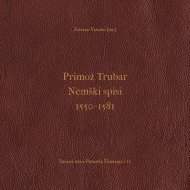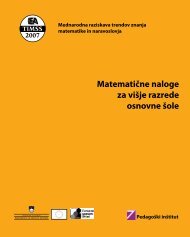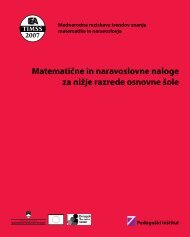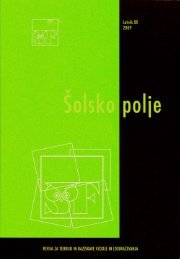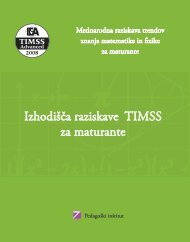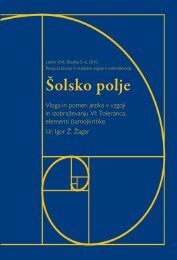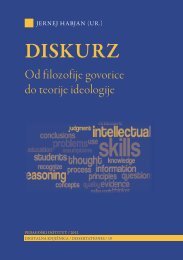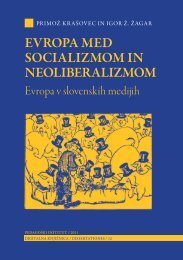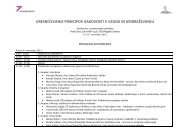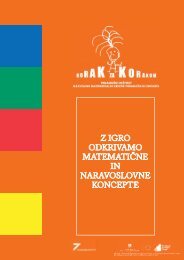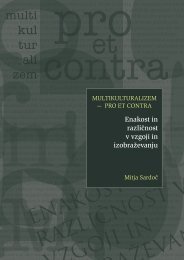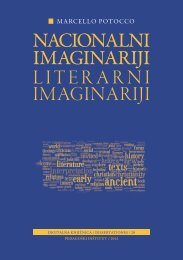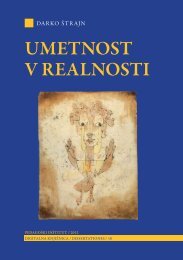68 ŠOLSKO POLJE LETNIK <strong>XX</strong> ŠTEVILKA 5/6An attentive reader will no doubt notice that most of the subtypes of classI are based on well-known semantic relationships from the Topical tradition:opposites, identity, similarity and part-whole/genus-species. However,Perelman and Olbrechts-Tyteca introduce an interesting case of identityrelationshipcalled ‘rule of justice’. The rationale of this special/new argumentscheme is in a warrant that asks for identical treatment of entities orsituations that can be subsumed under one and the same category.Another novelty is to be found under I.10: arguments of sacrifice aresupposed to increase the value of a goal by comparing it with the great effort,which has been invested to achieve it. And the gist of subtype I.11 liesin a presumption that some entities are considered to be similar enoughto justify quasi-probabilistic inferences.If we turn to the class II, we find three innovations: II.4 is used to argueagainst stopping before the goal of an action has been reached because ofthe energy already invested for performing the first stages of the action.II.5 is used to predict a definitive (disastrous) endpoint of a chain of causesand effects. And finally, II.6 also concerns predictions about chains ofcauses and effects, but in a positive way (unlimited development). So, in away, the New Rhetoric is moving from (more) formal to less formal use.But, in opinion of many argumentation theorists, The New Rhetorichas three main deficiencies:1) Perelman and Olbrechts-Tyteca do not develop sufficient criteria forthe distinction between sound and fallacious arguments.2) They rarely provide explicit reconstructions of arguments, despite theirclearly expressed intention to reconstruct their internal structure.3) They don’t develop systematic criteria for the demarcation of argumentschemes, and they don’t even claim that they are mutually exclusive.In other words, Perelman left topoi on a somewhat descriptive level, andexactly the same could be said for the Discourse-Historical Approach withinCDA 12 .But, in contrast to DHA, Perelman has made some very interestingand important observations regarding the role and the use of topoi in contemporarysocieties. He argued that (Perelman 1983: 114) even if it is thegeneral places that mostly attract our attention, there is an undeniableinterest in examining the most particular places that are dominant indifferent societies and allow us to characterize them. On the otherside, even when we are dealing with very general places, it is remarkable
TOPOI IN CRITICAL DISCOURSE ANALYSIS69that for every place we can find an opposite place: to the superiority oflasting, which is a classic place, we could oppose the place of precarious,of something that only last a moment, which is a romantic place.And this repartition gives us the possibility to characterize societies,not only in relation to their preference of certain values, but alsoaccording to the intensity of adherence to one or another member of theantithetic couple.This sounds like a good research agenda for CDA, as far as its interestin argumentation is concerned: to find out what views and valuesare dominant in different societies, and characterize these societiesby reconstructing the topoi that underlie their discourses. But inorder to be able to implement such an agenda - an agenda that is actuallyvery close to DHA’s own agenda -, DHA should dismiss »the list of (prefabricated)topoi« that facilitates and legitimizes its argumentative endeavorsomehow beforehand (the topoi are already listed, we just have to checkour findings against the background of this list of topoi), and start diggingfor the topoi in concrete texts and discourses.How does it achieve that?Curiously enough, the same year that Perelman and Olbrechts-Tytecapublished their New Rhetoric, Stephen Toulmin published his Uses ofArgument, probably the most detailed study of how topoi work. I say »curiouslyenough« because he doesn’t use the terms »topos« or »topoi«, butthe somewhat judicial term »warrant«. The reason for that seems obvious:he is trying to cover different »fields of argument«, and not all fields of argument,according to him, use topoi as their argumentative principles orbases of their argumentation. According to Toulmin (1958/1995: 94-107),if we have an utterance of the form, »If D then C« – where D stands for dataor evidence, and C for claim or conclusion – such a warrant would act asa bridge and authorize the step from D to C (which also explains whereManfred Kienpointner’s definition of topos comes from: not from Aristotlebut from Toulmin). But then, a warrant may have a limited applicability,so Toulmin introduces qualifiers Q, indicating the strength conferredby the warrant, and conditions of rebuttal (or Reservation) R, indicatingcircumstances in which the general authority of the warrant would haveto be set aside. And finally, in case the warrant is challenged in any way, weneed some backing as well. His diagram of argumentation looks like this:
- Page 3:
VSEBINA LETNIK XX ŠTEVILKA 5/6 Z
- Page 7 and 8:
UVODNA NOTICAIgor Ž. ŽagarTole pi
- Page 9 and 10:
ZA KAJ GRE V KAD - PREGLEDZGODOVINE
- Page 11 and 12:
ZA KAJ GRE V KAD - PREGLED ZGODOVIN
- Page 13:
ZA KAJ GRE V KAD - PREGLED ZGODOVIN
- Page 17 and 18:
ZA KAJ GRE V KAD - PREGLED ZGODOVIN
- Page 19 and 20: ZA KAJ GRE V KAD - PREGLED ZGODOVIN
- Page 21 and 22: ZA KAJ GRE V KAD - PREGLED ZGODOVIN
- Page 23 and 24: ZA KAJ GRE V KAD - PREGLED ZGODOVIN
- Page 25 and 26: ZA KAJ GRE V KAD - PREGLED ZGODOVIN
- Page 27 and 28: DISKURZ: FOUCAULT, LACLAU TERZAPOPA
- Page 29 and 30: DISKURZ: FOUCAULT, LACLAU TER ZAPOP
- Page 31 and 32: DISKURZ: FOUCAULT, LACLAU TER ZAPOP
- Page 33 and 34: DISKURZ: FOUCAULT, LACLAU TER ZAPOP
- Page 35 and 36: DISKURZ: FOUCAULT, LACLAU TER ZAPOP
- Page 37 and 38: DISKURZ: FOUCAULT, LACLAU TER ZAPOP
- Page 39 and 40: DISKURZ: FOUCAULT, LACLAU TER ZAPOP
- Page 41 and 42: DISKURZ: FOUCAULT, LACLAU TER ZAPOP
- Page 43 and 44: DISKURZ: FOUCAULT, LACLAU TER ZAPOP
- Page 45 and 46: DISKURZ: FOUCAULT, LACLAU TER ZAPOP
- Page 47 and 48: DISKURZ: FOUCAULT, LACLAU TER ZAPOP
- Page 49 and 50: TOPOI IN CRITICAL DISCOURSE ANALYSI
- Page 51 and 52: TOPOI IN CRITICAL DISCOURSE ANALYSI
- Page 53 and 54: TOPOI IN CRITICAL DISCOURSE ANALYSI
- Page 55 and 56: TOPOI IN CRITICAL DISCOURSE ANALYSI
- Page 57 and 58: TOPOI IN CRITICAL DISCOURSE ANALYSI
- Page 59 and 60: TOPOI IN CRITICAL DISCOURSE ANALYSI
- Page 61 and 62: TOPOI IN CRITICAL DISCOURSE ANALYSI
- Page 63 and 64: TOPOI IN CRITICAL DISCOURSE ANALYSI
- Page 65 and 66: TOPOI IN CRITICAL DISCOURSE ANALYSI
- Page 67 and 68: TOPOI IN CRITICAL DISCOURSE ANALYSI
- Page 69: TOPOI IN CRITICAL DISCOURSE ANALYSI
- Page 73 and 74: TOPOI IN CRITICAL DISCOURSE ANALYSI
- Page 75 and 76: TOPOI IN CRITICAL DISCOURSE ANALYSI
- Page 77 and 78: University of Queensland, Centre fo
- Page 79 and 80: JOURNALISTIC (RE)PRODUCTION OF HIST
- Page 81 and 82: JOURNALISTIC (RE)PRODUCTION OF HIST
- Page 83 and 84: JOURNALISTIC (RE)PRODUCTION OF HIST
- Page 85 and 86: JOURNALISTIC (RE)PRODUCTION OF HIST
- Page 87 and 88: JOURNALISTIC (RE)PRODUCTION OF HIST
- Page 89 and 90: JOURNALISTIC (RE)PRODUCTION OF HIST
- Page 91 and 92: JOURNALISTIC (RE)PRODUCTION OF HIST
- Page 93 and 94: JOURNALISTIC (RE)PRODUCTION OF HIST
- Page 95 and 96: JOURNALISTIC (RE)PRODUCTION OF HIST
- Page 97 and 98: JOURNALISTIC (RE)PRODUCTION OF HIST
- Page 99 and 100: JOURNALISTIC (RE)PRODUCTION OF HIST
- Page 101 and 102: JOURNALISTIC (RE)PRODUCTION OF HIST
- Page 103 and 104: THE VOICE OF AN AGENDA-SETTINGAUTHO
- Page 105 and 106: THE VOICE OF AN AGENDA-SETTING AUTH
- Page 107 and 108: THE VOICE OF AN AGENDA-SETTING AUTH
- Page 109 and 110: THE VOICE OF AN AGENDA-SETTING AUTH
- Page 111 and 112: THE VOICE OF AN AGENDA-SETTING AUTH
- Page 113 and 114: THE VOICE OF AN AGENDA-SETTING AUTH
- Page 115 and 116: THE VOICE OF AN AGENDA-SETTING AUTH
- Page 117 and 118: THE VOICE OF AN AGENDA-SETTING AUTH
- Page 119 and 120: THE VOICE OF AN AGENDA-SETTING AUTH
- Page 121 and 122:
THE VOICE OF AN AGENDA-SETTING AUTH
- Page 123 and 124:
THE VOICE OF AN AGENDA-SETTING AUTH
- Page 125 and 126:
THE VOICE OF AN AGENDA-SETTING AUTH
- Page 127 and 128:
THE VOICE OF AN AGENDA-SETTING AUTH
- Page 129 and 130:
THE VOICE OF AN AGENDA-SETTING AUTH
- Page 131 and 132:
THE VOICE OF AN AGENDA-SETTING AUTH
- Page 133 and 134:
THE VOICE OF AN AGENDA-SETTING AUTH
- Page 135 and 136:
‘68 KOT HKRATNA KRIZA EVROPSKEGAZ
- Page 137 and 138:
‘68 KOT HKRATNA KRIZA EVROPSKEGA
- Page 139 and 140:
‘68 KOT HKRATNA KRIZA EVROPSKEGA
- Page 141 and 142:
‘68 KOT HKRATNA KRIZA EVROPSKEGA
- Page 143 and 144:
‘68 KOT HKRATNA KRIZA EVROPSKEGA
- Page 145 and 146:
‘68 KOT HKRATNA KRIZA EVROPSKEGA
- Page 147 and 148:
‘68 KOT HKRATNA KRIZA EVROPSKEGA
- Page 149 and 150:
‘68 KOT HKRATNA KRIZA EVROPSKEGA
- Page 151 and 152:
‘68 KOT HKRATNA KRIZA EVROPSKEGA
- Page 153 and 154:
‘68 KOT HKRATNA KRIZA EVROPSKEGA
- Page 155 and 156:
‘68 KOT HKRATNA KRIZA EVROPSKEGA
- Page 157 and 158:
‘68 KOT HKRATNA KRIZA EVROPSKEGA
- Page 159 and 160:
POVZETKI/ABSTRACTSZA KAJ GRE V KAD
- Page 161 and 162:
POVZETKI / ABSTRACTS159NOVINARSKA (
- Page 163 and 164:
POVZETKI / ABSTRACTS161‘68 AS PAR
- Page 165 and 166:
AVTORJI/AUTHORSRuth WodakRuth Wodak
- Page 168 and 169:
166 ŠOLSKO POLJE LETNIK XX ŠTEV
- Page 170 and 171:
168 ŠOLSKO POLJE LETNIK XX ŠTEV
- Page 172:
ZAHVALARevija Šolsko polje izhaja



